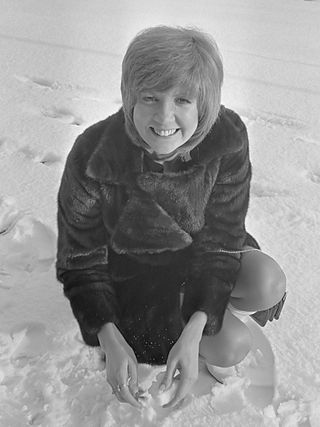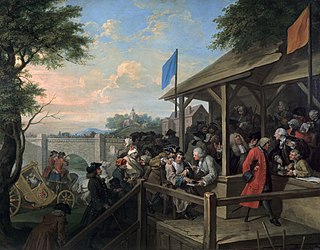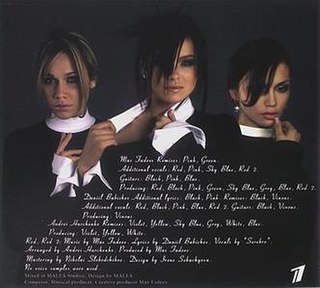Jennifer Jean Warnes is an American singer and songwriter. She has performed as a vocalist on a number of film soundtracks. She has won two Grammy Awards, in 1983 for the Joe Cocker duet "Up Where We Belong" and in 1987 for the Bill Medley duet "(I've Had) The Time of My Life". Warnes also collaborated closely with Leonard Cohen.

Priscilla Maria Veronica White, better known as Cilla Black, was an English singer and television presenter.

Political colours are colours used to represent a political ideology, movement or party, either officially or unofficially. They represent the intersection of colour symbolism and political symbolism. Politicians making public appearances will often identify themselves by wearing rosettes, flowers, ties or ribbons in the colour of their political party. Parties in different countries with similar ideologies sometimes use similar colours. As an example the colour red symbolises left-wing ideologies in many countries, while the colour blue is often used for conservatism, the colour yellow is most commonly associated with liberalism and right-libertarianism, and Green politics is named after the ideology's political colour. The political associations of a given colour vary from country to country, and there are exceptions to the general trends, for example red has historically been associated with Christianity, but over time gained association with leftist politics, while the United States differs from other countries in that conservatism is associated with red and liberalism with blue. Mass media has driven a standardization of colour by political party, to simplify messaging, while historically the colour a candidate chose to identify with could have been chosen based on other factors such as family or regional variations.

"Procession" is the second single by the British group New Order, released in September 1981 on 7" vinyl record. It is a double A side with "Everything's Gone Green". The single's Factory Records catalogue number is FAC 53.

True Colours is the sixth studio album released by New Zealand band Split Enz, and was their first major commercial success. Released on 21 January 1980, the album featured more pronounced contributions from co-lead singer and songwriter Neil Finn than previous releases. The album's New Zealand and Australian number 1 single, "I Got You", which also broke them internationally, is credited to him. The US release of the album featured "Shark Attack" and "I Got You" in reversed positions due to the latter's success on the single charts.
"The Candy Man" is a song that originally appeared in the 1971 film Willy Wonka & the Chocolate Factory. It was written by Leslie Bricusse and Anthony Newley specifically for the film. Although the original 1964 book by Roald Dahl contains lyrics adapted for other songs in the film, the lyrics to "The Candy Man" do not appear in the book. The soundtrack version of the song was sung by Aubrey Woods, who played Bill the candy store owner in the film. Anthony Newley sings the song on his 1971 album Pure Imagination.

"L'amour est bleu" is a song whose music was composed by André Popp, and whose lyrics were written by Pierre Cour, in 1967. Bryan Blackburn later wrote English-language lyrics for it. First performed in French by Greek singer Vicky Leandros as the Luxembourgish entry in the Eurovision Song Contest 1967, it has since been recorded by many other musicians, most notably French orchestra leader Paul Mauriat, whose familiar instrumental version became the first number-one hit by a French lead artist to top the Billboard Hot 100 in America.

"You're My World" is a cover of Italian ballad originally recorded in 1963 as "Il mio mondo" by Umberto Bindi, who co-wrote the original version with Gino Paoli. Subsequently, an English version was commissioned, and the lyrics were written by Carl Sigman as "You're My World". The song reached No. 1 in Australia (twice), Belgium, Mexico, Netherlands, South Africa and United Kingdom in recordings by Cilla Black, Daryl Braithwaite, Guys 'n' Dolls and Helen Reddy. Black's and Reddy's versions reached the US Top 40 in 1964 and 1977, respectively. The song also reached No. 1 in France and Spain in the respective translations "Ce monde" and "Mi Mundo", both sung by Richard Anthony.

"Alfie" is a song written by Burt Bacharach and Hal David to promote the 1966 film Alfie. The song was a major hit for Cilla Black (UK) and Dionne Warwick (US).
"Make It Easy on Yourself" is a popular song written by Burt Bacharach and Hal David which was first a hit for Jerry Butler in 1962. The best known version is the 1965 recording by the Walker Brothers for whom it was a No. 1 UK and Canadian hit. Dionne Warwick, who made a demo of this song in early 1962, later had a hit with the song in 1970.

"Heartbeat" is a rockabilly song originally recorded by Bob Montgomery and credited to Norman Petty. It was recorded most famously by Buddy Holly in 1958. The B-side of the single was "Well... All Right". "Heartbeat" reached the UK top 10 twice: once in 1975 for Showaddywaddy at number seven and again in 1992 for Nick Berry, recorded as the theme to the television series Heartbeat, which reached number two.
Rainbows is the youngest section of Girlguiding in the UK. They are between the ages of 4 and 7 and at the age of about seven, a Rainbow will usually become a Brownie if she wishes to continue Guiding.

"Song #1" is a song by Russian girl group Serebro. It is best known as Russia's entry to the Eurovision Song Contest 2007, held in Helsinki, Finland. They performed in the 15th position in the final, following Latvia's Bonaparti.lv with "Questa notte" and preceding Germany's Roger Cicero with "Frauen regier'n die Welt". It finished in third position with 207 points, behind second placed Ukraine and winner, Serbia.

The Best of Cilla Black is a compilation album by Cilla Black. It was first released in 1968 and originally included 14 of her biggest hit singles, a selection of B-sides and album tracks, released between 1963 and 1968. Many of these tracks had not been previously available on an album. It was usual in this period for artists to record songs exclusively for single release only. The album reached number 21 on the UK Albums Chart.
"The House of the Rising Sun" is a traditional folk song, sometimes called "Rising Sun Blues". It tells of a person's life gone wrong in the city of New Orleans. Many versions also urge a sibling or parents and children to avoid the same fate. The most successful commercial version, recorded in 1964 by the British rock band The Animals, was a number one hit on the UK Singles Chart and in the US and Canada. As a traditional folk song recorded by an electric rock band, it has been described as the "first folk rock hit".

"Black and Yellow" is a song by American rapper Wiz Khalifa from his third studio album, Rolling Papers. It was released on September 14, 2010, as the lead single from the album. The song was written by Khalifa, along with Stargate, who produced it. It was released as a CD single in honor of Record Store Day. The song peaked at number one on the Billboard Hot 100, becoming Wiz Khalifa's first number-one single in the US.

Completely Cilla: 1963–1973 is a compilation album released of music by British pop singer Cilla Black. The compilation album is a prelude to Black's 50th anniversary in show business – it is the largest released compilation album of her music containing 139 digitally remastered recordings.

Feelings is an album by American pop singer Johnny Mathis that was released on October 20, 1975, by Columbia Records and strayed slightly from the practice of covering hits by other artists to include two new songs, both of which were written by Jerry Fuller: "Hurry Mother Nature" and "That's All She Wrote", which Ray Price took to number 34 on the Country chart the following spring.
The Official New Zealand Music Chart is the weekly New Zealand top 40 singles and albums charts, issued weekly by Recorded Music NZ. The Music Chart also includes the top-20 New Zealand artist singles and albums and top 10 compilation albums. All charts are compiled from data of both physical and digital sales from music retailers in New Zealand.

The Very Best of Cilla Black is a career-spanning compilation album by English singer Cilla Black, released in October 2013 by Parlophone / Warner Music Group UK to mark her golden anniversary in show business. The album reached No. 37 in 2013 on the UK Albums Chart, which was Black's first Top 40 hit in thirty years. In September 2014, after the transmission of ITV biopic Cilla starring Sheridan Smith the album re-entered the UK Albums Chart and peaked at No. 26. The album was to make its ultimate peak at No. 1 after Black's death in August 2015, becoming her first number-one album. It also reached No. 1 in New Zealand on 21 August 2015 and stayed there for five consecutive weeks, making it the first album to achieve this since Sol3 Mio's eponymous album in March 2014.













